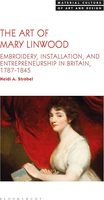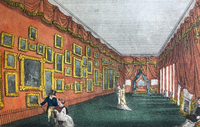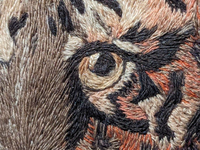The Art of Mary Linwood: Embroidery, Installation, and Entrepreneurship in Britain, 1787–1845 by Heidi A. Strobel
Reviewed by Theresa Kutasz ChristensenTheresa Kutasz Christensen
Private Consultant for Exhibition and Provenance Research
The Pennsylvania State University
Email the author: TKutaszChristensen[at]gmail.com
Citation: Theresa Kutasz Christensen, book review of The Art of Mary Linwood: Embroidery, Installation, and Entrepreneurship in Britain, 1787–1845 by Heidi A. Strobel, Nineteenth-Century Art Worldwide 23, no. 2 (Autumn 2024), https://doi.org/10.29411/ncaw.2024.23.2.8.
This work is licensed under a Creative Commons Attribution-NonCommercial 4.0 International License  unless otherwise noted.
unless otherwise noted.
Your browser will either open the file, download it to a folder, or display a dialog with options.

Heidi A. Strobel,
The Art of Mary Linwood: Embroidery, Installation, and Entrepreneurship in Britain, 1787–1845.
London: Bloomsbury, 2024.
256 pp.; 16 color and 46 b&w illus.; catalogue; end notes; selected bibliography; index.
$120.00 (hardcover)
ISBN: 9781350428096

The entrepreneur, artist, and educator Mary Linwood (1755–1845) specialized in crewelwork embroidery, opening a successful gallery in Leicester Square in 1809. The Leicester Square gallery (fig. 1) contained both original designs and skillfully made reproductions of pieces by leading painters, set into fashionable and immersive display environments and all available to the public to view for a modest fee. Linwood had been so confident in this gallery project that she signed a forty-nine-year lease in 1806, keenly anticipating the commercial success of her groundbreaking installation, which remained open—although not necessarily still in the height of fashion—until her death. Because Linwood did not sell her works and instead put her entire oeuvre on exhibition in her gallery while publishing guides to the collection, she is something of an anomaly of early modern women artists in that we have knowledge of the subject of nearly every professional work she produced.
The Art of Mary Linwood: Embroidery, Installation, and Entrepreneurship in Britain, 1787–1845—part of Bloomsbury’s Material Culture of Art and Design series—joins a chorus of recent work by authors such as Paris Spies Gans, Amelia Rauser, Serina Dryer, Chloe Wigston Smith, Barbara Burman, Ariane Fennetaux, Isabella Rosner, and Zara Anishanslin that foregrounds the cultural and artistic contributions of pre-modern women artists in the British Atlantic world with an incisive view toward addressing longstanding hierarchies of media and avenues for women’s access to education, professionalization, and entrepreneurship.
Author Heidi Strobel outlines Linwood’s remarkable career. The text spans the artist’s lifetime but, as the title reflects, Strobel does not simply reconstruct Linwood’s biography. Instead, she focuses on outlining and contextualizing the artist’s oeuvre while offering the first in-depth study of Linwood’s life and career. Given the fact that Linwood has never been the subject of a modern monograph, some may question the author’s choice to not produce a biography in keeping with that most traditional of Vasarian art historical modes of establishing an artist’s unique genius—ostensibly a prerequisite for any consideration of their addition to the canon. It is, however, Strobel’s explicit rejection of the monographic format—along with its privileging of the patriarchal structures of academic training, artistic genius, and the paintbrush or chisel as the only avenues to canonical relevance—that sets the tone for her convincing correction to the injustice of Linwood’s absence from the histories of late Georgian and early Romantic art history. The book presents a fulsome picture of Linwood’s career, drawing on the social, economic, and artistic impact of her work, which act in concert to justify the artist’s proposed reintegration into the art historical canon and address the gendered structures that relegated her in the first place.
Linwood worked in worsted wool and silk, stitching threads that move like brushstrokes in waves across her “needle-paintings,” as they were called in her time (see, e.g., figs. 2, 3). As a woman who chose never to marry, she was free to pursue both her entrepreneurial and artistic goals. In the volume’s introduction, Strobel sets up her discussion of Linwood’s installations within their broader period frameworks. This includes the contextualization of both the subject matter of her works within nationalistic trends and her displays’ visual engagement with contemporaneous exhibitions, entertainments, and galleries. The volume’s overarching structure documents the artist’s formative years and education in embroidery, early exhibitions and social mobility, professional accomplishments and self-fashioning, and lasting impact on British art and cultural history. As the majority of Linwood’s works were embroidered reproductions of well-known paintings, the text engages meaningfully with broader art historical topics that remain exceptionally relevant today, including the gendering of embroidery as an artistic medium and the place of the copy within artistic hierarchies imposed both within Linwood’s lifetime and posthumously.


Chapter 1 lays out the background of Linwood’s success in needlework, locating her development of the skill within her own familial and social background but also within the scope of embroidery as both gendered pastime and commercial enterprise. Expounding upon the Linwood family’s background in both the luxury goods market and in education (as the owners of a boarding school for girls known as the Priory), Strobel teases apart the delicate societal balance of promotion and demure deference to period norms navigated by many of Linwood’s artistic women contemporaries. Her early exhibitions, introduction to Queen Charlotte, and the international fame of her work as reflections of her self-promotion are considered in balance with a close reading of Linwood’s self-portrait after a pastel by John Russell with the work accomplishing versatile and parallel goals for the artist.
In the second chapter, key works in Linwood’s significant expansion of her publicly displayed oeuvre are discussed in relation to her exhibitions at the Pantheon on Oxford Street and at the Hanover Square gallery in London. These, in turn, are described within the parameters, opportunities, and limitations of the professionalized art world of late eighteenth-century London. The Pantheon show—which featured twenty works, was accompanied by a printed pamphlet, and received the queen’s blessing—is discussed as a preface to Linwood’s later, much larger shows at Hanover Square and Leicester Square. It is positioned as a formative foray into Linwood’s patriotic promotion of the British school of painting, her self-promotion as a feminine maker of fine embroidery, an early catalyst for her social access to art, and as a test of the clever advertising that would ensure her later success. In exploring these themes, the reader experiences the push and pull of Linwood’s navigation of the period’s dichotomous existence in which many women artists lived—namely, that of the amateur versus professional, acceptance in the space of the academy versus the educated artistic community, the creation of entertainment or craft versus art, and commercial success versus the possibility of becoming a social pariah.
Having already established how Linwood promoted herself through the development of exhibitions, social networking, and the establishment of her work within popular and well-regarded genres, Strobel takes a deeper look at avenues and results of Linwood’s publicity in chapter 3. These topics are discussed in relation to publications and advertisements for the Hanover and Leicester galleries as well as in the context of her promoting a traveling exhibition that raised funds to support herself and her family and promoted her international profile. This chapter is particularly well placed within the volume, as it allows space to dig deeper into both the targeted female demographic of the magazines that promoted Linwood and the alignment of her entrepreneurial endeavors with those of other contemporary women artists. By foregrounding the dilemma of how professional women presented themselves in British society—be it as muse, teacher, spinster, virtuous maid, fashionable lady, or Praxitelean sculptor of thread—Strobel underscores Linwood’s understanding of art as business and her location within histories of established women artists, British artists, and embroiderers.
The subject of the fourth and fifth chapters is the Leicester Square gallery—its renovation, contents, and installation. Chapter 4 focuses on the patriotic (but distinctly nonpartisan) themes of the galleries. Linwood positioned her work within traditions of British landscape and genre painting, drawing on nationalistic pride and nostalgia to help boost ticket sales and assert herself as part of the British canon. Strobel discusses Linwood’s engagement with the specific themes and artists she chose to represent and present while additionally drawing on the artist’s published gallery guides and the British poetry they contain to contextualize her contemporary reception. The immersive quality of the installations comes to a head in Strobel’s discussion of the Scripture Room. As the final room in the gallery—the space from which the highest percentage of works are still extant and which housed a thematically unique display of continental Old Master works—the Scripture Room is the subject of an in-depth study in chapter 5.
The sixth and final chapter explores Linwood’s legacy: her dual roles as artist and as teacher running the Priory exponentially increased her direct impact on multiple generations of young women. Linwood used her fame to finance and promote the Priory. In turn, many of the girls who attended the school to train under Linwood became skilled amateur and professional artists working in media such as lithography, drawing, printing, engraving, and embroidery. In focusing on Linwood’s lasting influence and legacy, Strobel chronicles the dissolution of Linwood’s personal collections of works by other artists as well as the contents of the Leicester Square gallery and the Priory. The volume concludes with a brief analysis of the ways in which the medium and practice of needlework shifted between Linwood’s death in the 1840s and the turn of the twentieth century. Though only a few pages, this section is essential to Strobel’s central point that, like many other women makers of her time, Linwood was by all measures a canonical artist in her own day but lost this status as the criteria for canonicity shifted. Through discussions of changes in manufacturing, the status of the amateur, the perceived value of artistic copies and reproduction, and stylistic tastes, Strobel demonstrates how an artist such as Linwood was excised from the canon while the slightly later (and male) William Morris found a central place in the history of embroidery.
Among its most significant contributions to continued scholarship on Linwood is the volume’s inclusion of a partially illustrated catalogue of all of the artist’s known works—including both those whose present location is known and unknown—that is over thirty pages in length. The list is organized by the name of the original artist of the works referenced in the needle-paintings. Thirty-six unique artists are represented as well as four works for which the designs have been attributed to Linwood herself. The entries provide tombstone data on each piece beginning with the header naming the artist of the painted original, followed by the title and, when known, the current owner or institution, an indication of whether the work was signed, the dimensions, and the location and year of its debut. Due to the extreme variation in documentation for each work, the written explanations vary from just a few lines to several paragraphs containing a description, information about the painter and the work on which Linwood based her needlework copy, the period significance that each piece might have held for Linwood’s British audiences, and a sketch of the needle-painting’s known fate or provenance prior to its entry into modern collections.
The volume contains seventy-four illustrations, inclusive of sixteen full-page color images and a figure showing the layout of the Leicester Square gallery. This generous number of images includes numerous portraits of the artist produced by both male and female contemporaries and an accomplished self-portrait in needlework alongside a slightly less polished self-portrait from the artist’s own scrapbook dated to 1826 and now in the collection of the Leicester Museums and Galleries. The depth of Strobel’s archival research is reflected in the variety of illustrations provided, which includes details of well-known works as well as period views that help to contextualize Linwood within the time and place she worked. Given the complex and intricate nature of Linwood’s embroideries, the reader is still left desiring larger illustrations and more color. This volume will be a smart addition to graduate-level courses in art history and gender and material studies and will appeal to scholars of the historical art market, the history of museums, Georgian studies, and women artists.
In order to justify women’s incorporation into established art historical narratives, scholars of historical women artists are often pressed to create an exceptional biography that will somehow make them worthy of a place in the canon. This was the driving thesis behind Andaleeb Badiee Banta’s essay “Not Seen Not Heard: In Search of the Unexceptional Woman Artist” in the recent exhibition catalogue for Making Her Mark: A History of Women Artists in Europe, 1400–1800 (2023), a show that featured Linwood’s work amid her peers working in a diverse array of circumstances and media.[1] While Linwood’s historical and artistic value might be summarized by her status as the first woman artist to own her own gallery in London, Strobel expertly illustrates a more holistic view of the artist working not as an exception but as part of a rich artistic tradition. Linwood’s broader impact was defined by a spirit of innovation and her skillful navigation of systems of professionalization designed to keep women and crafts people out. Her artistic legacy invites consideration on the interplay of innovation, education, materiality, gender expectations, nationalism, professionalism, and entrepreneurship. Strobel is hardly the first scholar to attempt to redress the historical wrongs inherent in the nineteenth and early twentieth century’s misogynistic rewriting of art history, which removed women’s accomplishments from the western canon. But in reclaiming Linwood’s significance to British art history, Strobel sets forth in this volume a clear blueprint for others aiming to tell the stories of artists and makers whose experiences lay outside of the boundaries of canonical representation.
Notes
[1] See Andaleeb Badiee Banta, “Not Seen Not Heard: In Search of the Unexceptional Woman Artist,” in Making Her Mark: A History of Women Artists in Europe, 1400–1800, eds. Andaleeb Badiee Banta, Alexa Greist, and Theresa Kutasz Christensen (Fredericton, NB: Goose Lane, 2023), 15–28.